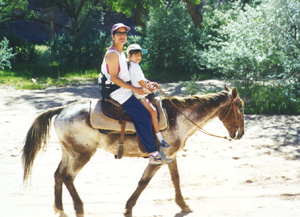

Visitor Management: On-Line Lesson
This Module is based on the Galapagos National Park (GNP). The issues raised are applicable to all ecotourism sites and the challenges for the protected area agency (land management agency); concessionaires and local communities. For an overview of the Galapagos National Park (See International Galapagos Tour Operators Association). Please review the visitor management challenges facing GNP according to the International Tour Operators Association (See Issues Facing the Galapagos).
![]()
Goal of Visitor Management
The number of visitations to a protected ecotourism area should not be allowed to exceed the management capability to handle such private or commercial visits.
![]()
Current Visitor Management Problems:
| visitor health and safety | |
| introduction of nonindigenous (exotic) plant and animal species | |
| guide training and pay scales | |
| pressure to increase the number of visitation zones | |
| tour scheduling | |
| need for new facilities |
![]()
Concessionaires Visitor
Responsibilities
|
Protected Area Manger's
Responsibilities
|
![]()
Visitor Management Issues
Permits (Types)
|
License to operate a concession: a business's professional ability to provide quality tours of a specific type: marine, river, horseback, hiking, diving or lodging tours (See The state parks of Alaska). The acquisition of a permit allows a business to operate using public resources. Protected area managers should have control over permit issuance. Permits to operate in an assigned area: These permits relate to zoning and whether allowing a concessionaire to operate in a given area will enhance the management objectives for the area. |

Guided Truck Tour |
Park Staffing and Personnel
The presence of identifiable park staff: create a hospitable environment for visitors; ensure visitor compliance with park rules and policies; and increase visitor safety.
Park staff should not only be found at visitor and interpretive centers but on regular and random patrols throughout the protected area.
Providing Commercial and Noncommercial Visitor Opportunities
|
Create a balance between the areas and activities provided by commercial vendors and those offered directly by the protected area's management. Options to offering more commercial activity within a protected are is to promote the development of private lands adjacent to the protected area. New facilities offering diverse recreational experiences in less environmentally sensitive areas should be developed to relieve visitor pressure form existing sites in fragile areas. |

Guided Horse Tour |
Zoning
Zoning is used to protect resources and provide diverse visitor experiences. Zoning should be based on the "impact" on the environmental and visitor's experience. Zoning may be based on:
| resource limitations (soil type, altitude, precipitation, unique features, needs of wildlife) | |
| desired visitor opportunities (availability, type, location and distribution of visitor amenities) |
Zones should be established and managed for distinctive setting attributes (what is desirable for visitor density; evidence of human activity; remoteness; type of travel; appropriate equipment and level of regulation).
Pairing Visitor Motivation With Particular Setting Attributes Increase Visitor Satisfaction
Proposed Zoning Spectrum
|

Guided Jeep Tour |
Setting Attributes
![]()
Regulations for Visitor Management
Once "zones" are established then regulations for each area can be set. Regulations are based on a combination of:
| carrying capacity | |
| ecological criteria | |
| visitor experience opportunities |
Use zones not managed for the integrity of specific setting attributes will evolve to heavier visitor use; a more developed setting; increased evidence of human activity; and easier access.
![]()
Limits of Acceptable Change (LAC)
Most zoning efforts are based on some type of carrying capacity concept. however, there is no direct correlation between numbers of visitors and negative impacts that affect soil, vegetation, wildlife or other visitors' experiences. The degree of impact depends on many variables including:
| degree of site hardening | |
| motivations and visitor behaviors | |
| mode of transportation | |
| types of lodging | |
| effectiveness of guides and park personnel | |
| group size | |
| environmental variables (soil type, slope, vegetation types, precipitation and season of use) |
LAC Process
For complete LAC process (See Limits of Acceptable Change and Limits of Acceptable Change: A Framework for Managing National Protected Areas: Experiences from the United States).
![]()
Trails
Trails are critical in any protected area. The proper design of a trail system will help control environmental impact and enhance visitor experiences. Proper trail design and maintenance will avoid costly trail reconstruction efforts. Trails should be properly graded (not to exceed 6% grade), hardened, sloped for drainage, and of a width consistent with the type of use planned.
[return to Module Four] [Class]
![]() Copyright
1998 Northern Arizona University, ALL RIGHTS RESERVED
Copyright
1998 Northern Arizona University, ALL RIGHTS RESERVED